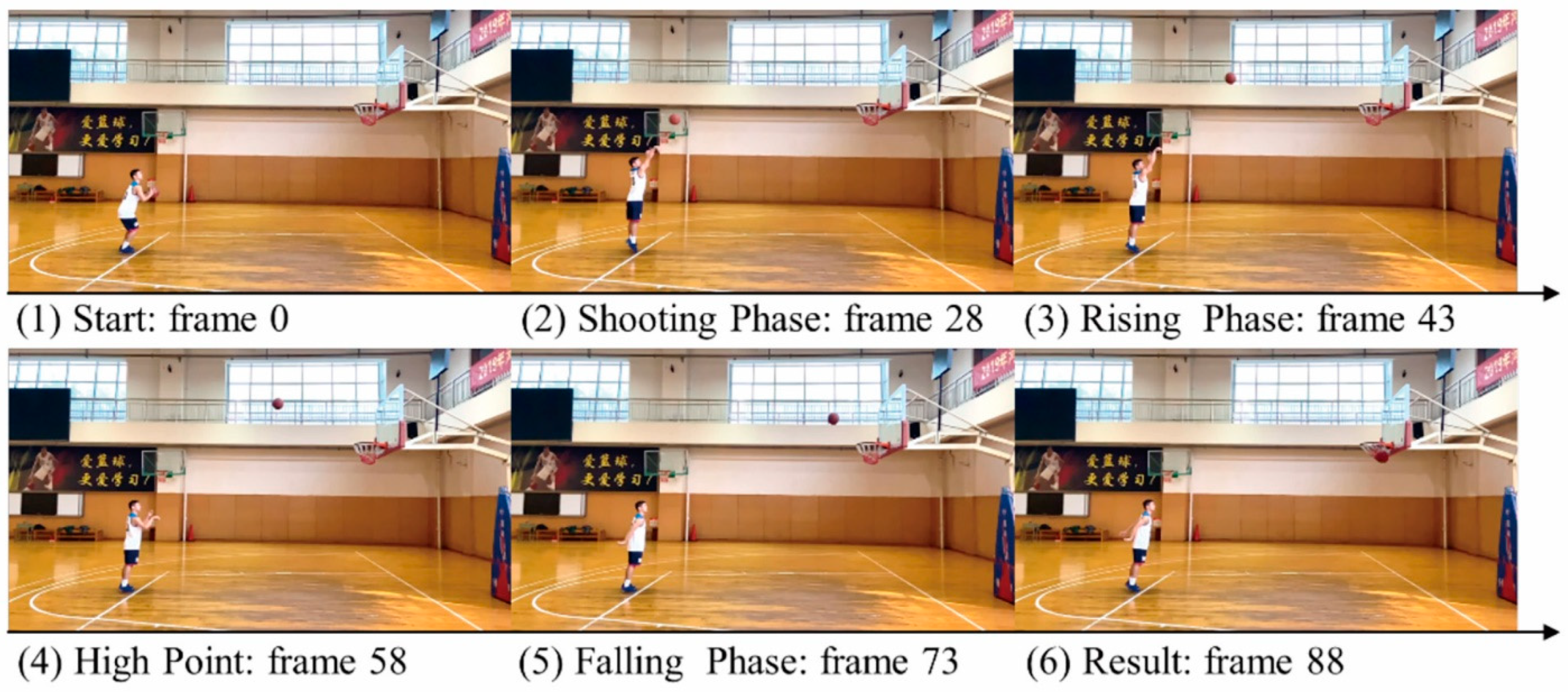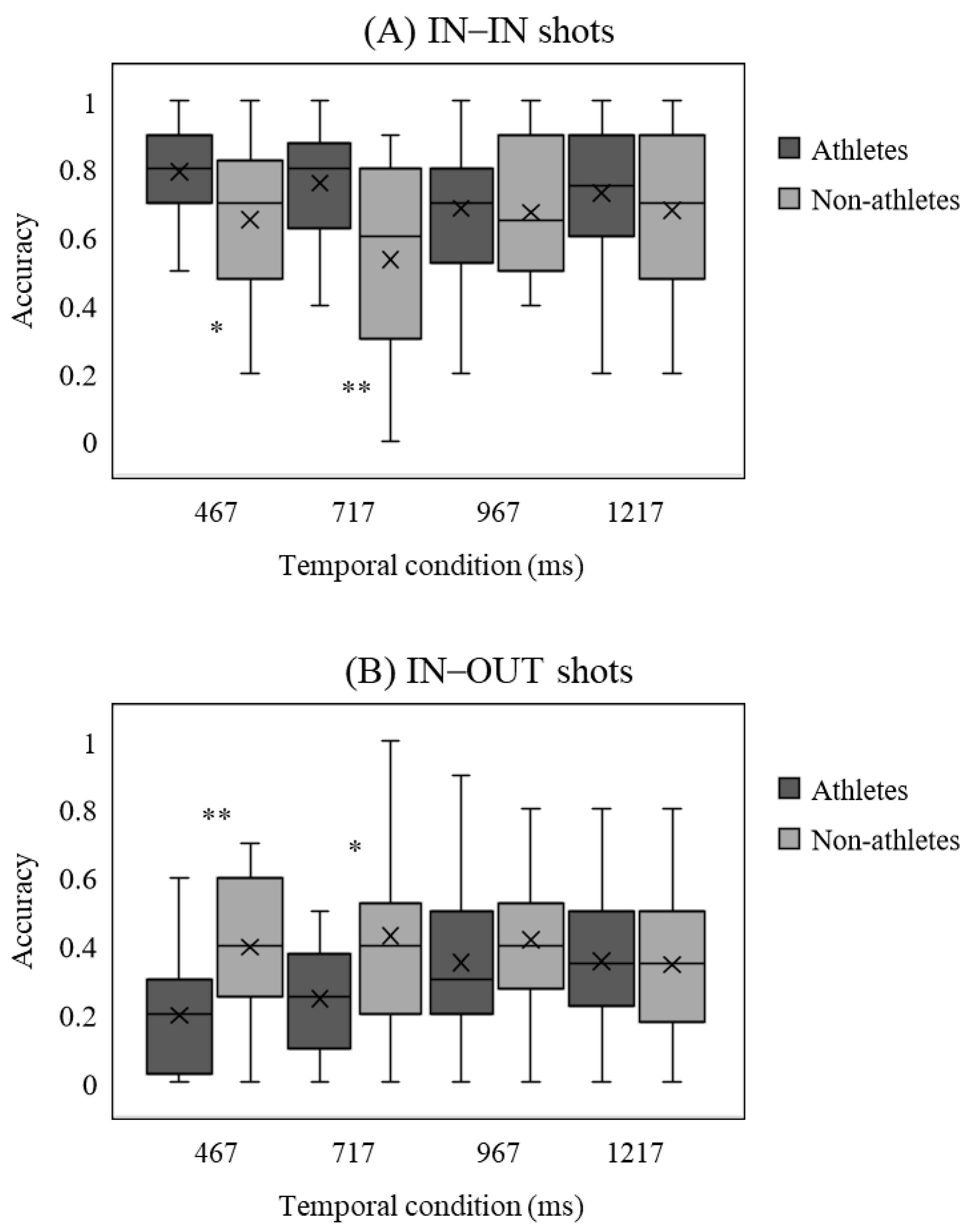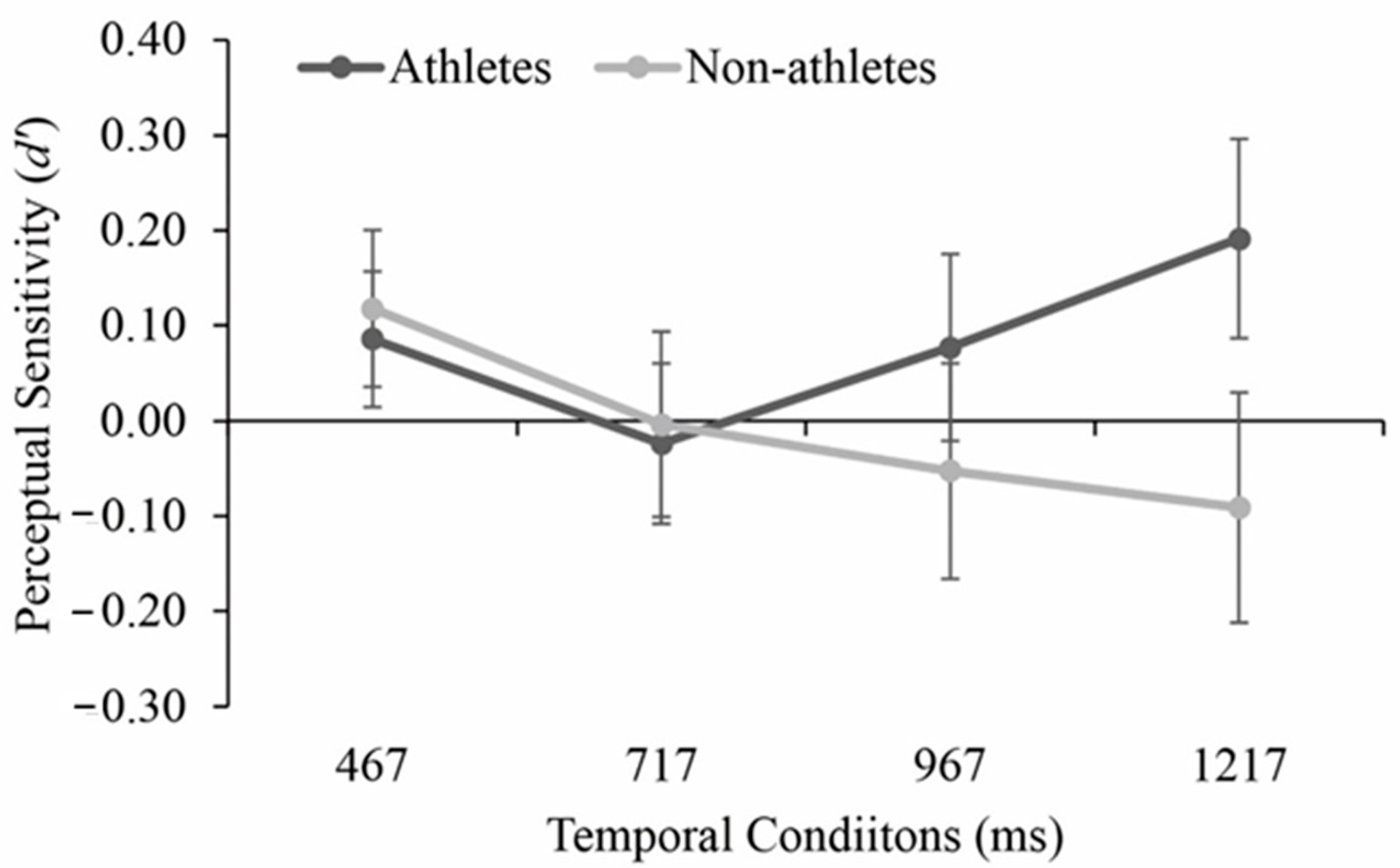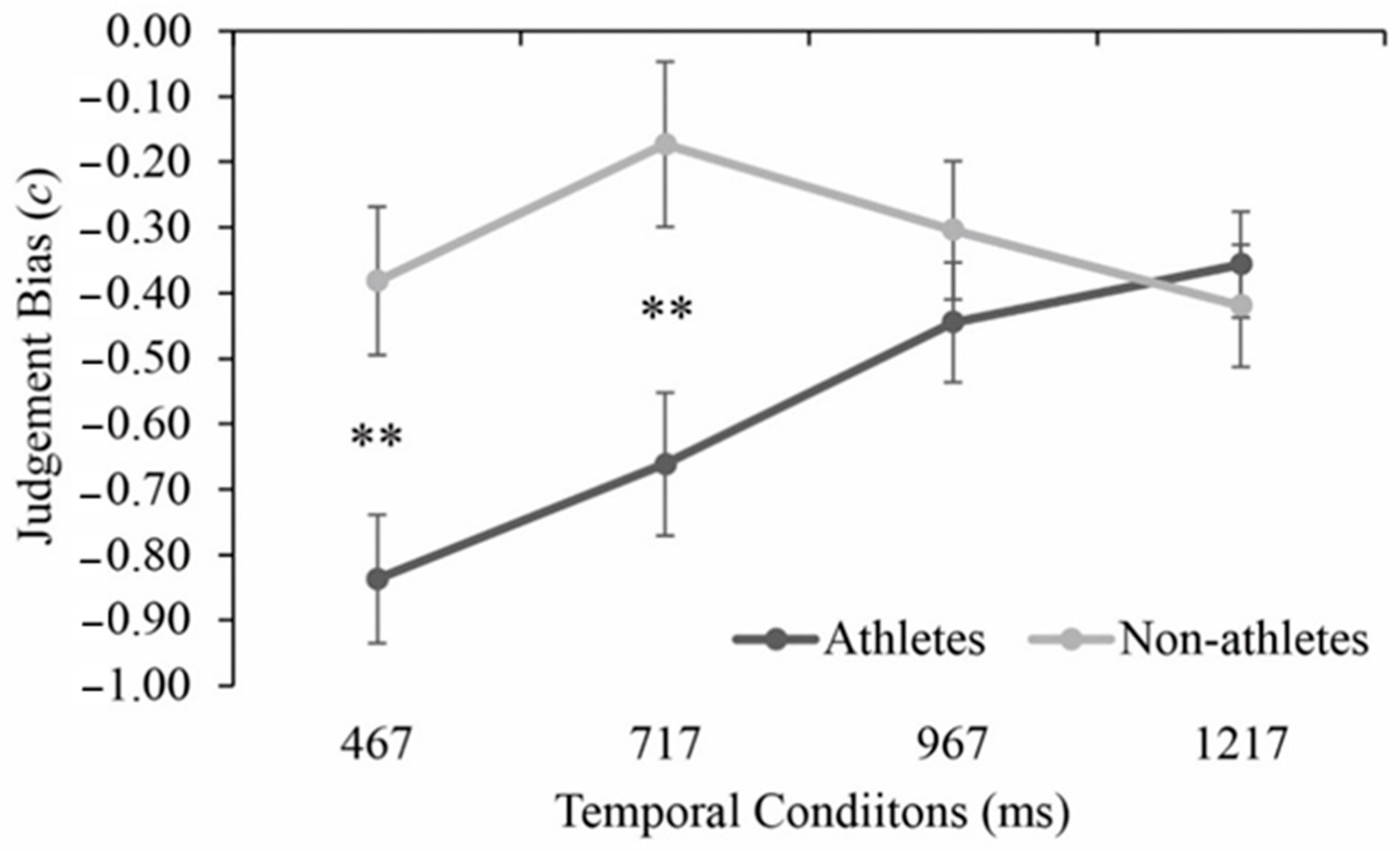1. Introduction
Action anticipation is the ability to predict an event’s outcome [
1]. In the context of basketball, keeping alert and making accurate anticipation of every shot can help a team win. Therefore, seeking the cognitive process of action anticipation of a shot is essential for basketball players.
As noted by several studies, expert basketball players demonstrated better anticipation than novices [
2,
3,
4], but the advantage was affected by the shot results [
5,
6,
7]. Interestingly, experts could not predict better in all basketball shots. Studies have found that the advantage of athletes only exists in predicting successful shots. Cañal-Bruland, Balch, and Niesert [
7] found higher accuracy for basketball players when they were predicting their own made shots. Moreover, another study demonstrated that, compared to the novices, expert players’ predictions were even less accurate for their own missed shots [
5]. That is, a judgement bias towards better prediction of their successful shots was illustrated when the athletes were performing basketball shots. Moreover, the results above were confirmed by signal-detection theory.
The experts’ judgement bias has been interpreted as the effect of “regulatory fit” [
6]. The theory of regulatory focus presents two types of individual focus, namely promotion focus and prevention focus [
8]. People who have a promotion focus adopt more positive behavioral strategies to win the game. On the contrary, individuals with a prevention focus are more inclined to avoid failure and adopt conservative strategies [
9]. The effect of regulatory fit emerges when the action strategy is consistent with one’s focus. Therefore, predicting a shot as “in” is a positive strategy that may fit experts’ promotion focus, causing a regulatory fit. Since expert basketball players have higher motivation to win a match, they show a self-regulatory focus, i.e., “focus on gains”, and a behavioral strategy, i.e., “search for a win”. A study found that the regulatory fit led to a broader scope of attention in a basketball shot task [
10]. As explained earlier, experts with a “focus on gains” were sensitive to positive results [
11], so the regulatory fit could help them improve their performance. Another possible explanation is that the athletes’ judgment bias might be caused by top-down processing. It is demonstrated that physical movement and motor imagery share a common process [
12], and action prediction is regarded as “motor resonance”, which reflects a mirror-like activity in the observer’s motor system during action observation. Though this process has always been identified as an inner, automatic replica of the observed movement, predictive coding models suggest that top-down modulation makes motor resonance a less faithful replica [
13]. Therefore, considering the notion that mirroring the observed actions of others underlies action understanding, basketball experts’ judgement bias was explained.
There are two kinds of shot prediction, that is, predicting one’s own shot and predicting another’s shot. Cañal-Bruland, Balch, and Niesert [
7] asked basketball players to perform free shots. When the ball was released by themselves or others, basketball players’ and observers’ vision was occluded, and they were asked to report the fate of the ball. Results showed higher accuracy for basketball players when they were observing their own made shots. Therefore, with the accumulation of professional training, athletes can compare their proprioception with the standard action. By doing this, experts can be aware of their movement errors. On the other hand, successfully predicting another’s shot as an observer maybe even more important than anticipating one’s own shooting. As a player, watching others throw a ball during a basketball game occurs much more often than throwing it oneself. However, previous studies revealed contradictory results. Our research showed collegiate players and recreational players demonstrated higher accuracy than the non-athletes when predicting another’s shooting. This kind of advantage may be benefited from the process of embodied cognition, which suggests that cognitive processes are deeply rooted in the interactions between the body and the environment [
14]. However, in the study of Cañal-Bruland, Balch, and Niesert [
7], basketball observers did not predict more accurately for the made shots as the players did. To explain this, the motivational differences and the quantity and quality of information must be discussed.
It is worth noting that the cues of a successful shot come not only from the shot result of the ball but also from the shooter’s body. In general, a player’s body posture shows his or her early action intention, and the ball trajectory shows a later shot result. However, a recent study found the collegiate players were superior to the non-athletes in predicting made shots regardless of whether they watched the shooting, rising, high point, or falling phase of a shooting [
6]. However, the kind of cues that induce an experts’ judgement bias remains unclear. A few researchers surveyed how the movement cues are applied by experts in different temporal phases and shot results. In a study of table tennis, Zhao et al. [
15] created congruent and incongruent body–ball cues and found players were superior in anticipating the ball trajectory using body movements’ incongruent conditions, but the superiority vanished when the ball trajectory was incongruent to the action. Nevertheless, before a racquet player starts a serve, he or she has already decided the ball direction. The ball trajectory is always congruent with their action trend. To some extent, employing inauthentic video clips in their study was questionable. Previous research of shot anticipation was hard to identify in regards to whether the experts rely more on the body movement of the players or the ball trajectory.
During an anticipation task, the interaction between temporal information and two kinds of cues is also crucial. Using the temporal occlusion paradigm, Wu et al. [
3] divided the temporal course of a shot (which had 11 continuous pictures) into early (three pictures), middle (six pictures), and late phases (nine pictures), and asked basketball players to predict the result under different temporal phases. It was revealed that experts presented higher accuracy than the novices when watching three or six pictures. That is, the experts can make better use of incomplete cues than novices. Concerning the judgement bias, Li and Feng [
6] compared the accuracy of basketball players with varying levels and non-athletes under different temporal conditions. It was reported that collegiate players outperformed recreational players and non-athletes regardless of the temporal condition when presented with successful shots, supporting the notion that experts can match the proprioception of their shots to the visual information of others’ shots. In terms of the “regulatory fit” theory, athletes’ improvement is supposed to have higher motivation to exert their best effort to win a match, reflecting a regulatory focus of promotion. Additionally, this finding was also reported by studies investigating table tennis and tennis. A study by Zhao, Lu, Jaquess, and Zhou [
15] showed that, compared to middle-level and novice players, expert athletes used early, effective information to get better predictions. Moreover, research on squash indicated that the most critical periods for extracting information about stroke direction are 160–80 ms before racket–ball contact and the ball flight, arising at least 80 ms after contact [
16]. A possible explanation for this might be that athletes have a better ability of visual perception, which is gained in years of sports training. Generally speaking, early visual information includes body cues, and later visual information involves the flying trajectory of the ball. Regarding the judgement bias, whether it affects the early or later cue utilization and the performance of shot prediction in basketball athletes has not been surveyed by researchers.
A basketball player always wants to hit the ball, though the result may sometimes be disappointing. Athletes can never know the result of a shot until the ball goes into the basket or bounces away, that is, his or her action of shot may be incongruent with the actual ball trajectory. Concerning this, the present study was designed to determine the interplay of kinematic information and ball trajectory during a shot prediction as well as the effect of judgement bias and temporal phase. We used four types of expectation–result (body–ball) shots: IN–IN, IN–OUT, OUT–IN, and OUT–OUT. As was pointed out earlier, experts have judgement bias for made shots, so we predicted that they will outperform the novices in IN–IN condition but perform worse in OUT–OUT condition (Hypothesis 1). As far as the cue utilization is concerned, it is hypothesized that experts will present lower accuracy in IN–OUT condition than the non-athletes if their judgement bias relies on body cues; on the contrary, if the experts’ judgement bias relies on the ball cues, they will show better performance in OUT–IN condition (Hypothesis 2). Moreover, according to previous studies [
5,
7], signal-detection theory was employed to examine the judgement bias. We hypothesized that athletes were significantly more biased toward predicting the shots as “in” than the non-athletes (Hypothesis 3).
3. Results
Significant main effects of the shot type of body–ball cues,
F (3, 120) = 25.64,
p < 0.001, η
p2 = 0.57, and the interaction between shot type × temporal condition,
F (9, 360) = 2.69,
p < 0.05, η
p2 = 0.12, were shown. Additionally, the three-factor interaction between shot type × temporal condition × group was significant,
F (9, 360) = 2.93,
p < 0.05, η
p2 = 0.13. Post-hoc analysis of the four shot types and four temporal conditions found that for IN–IN shots, players had higher accuracy than the non-athletes under the shooting (athletes: 0.79 ± 0.15, non-athletes: 0.65 ± 0.25) and rising phases (athletes: 0.76 ± 0.16, non-athletes: 0.53 ± 0.28,
p < 0.05,
d > 0.68 in all instances); for OUT–IN shots, better performance of athletes than the non-athletes was found under the shooting (athletes: 0.80 ± 0.14, non-athletes: 0.66 ± 0.24) and high point phase (athletes: 0.66 ± 0.21, non-athletes: 0.52 ± 0.23,
p < 0.05,
d > 0.64 in all instances). However, experts showed lower accurate predictions for IN–OUT condition and OUT–OUT condition than the non-athletes (
p < 0.05,
d > 0.72 in all instances) for the shooting (IN–OUT: athletes: 0.20 ± 0.17, non-athletes: 0.40 ± 0.24; OUT–OUT: athletes: 0.25 ± 0.16, non-athletes: 0.39 ± 0.21) and rising phases (IN–OUT: athletes: 0.25 ± 0.16, non-athletes: 0.43 ± 0.28; OUT–OUT: athletes: 0.28 ± 0.17, non-athletes: 0.43 ± 0.24,
Figure 3.). Moreover, both the athletes and the non-athletes showed higher accuracy for IN-IN and OUT-IN shots than IN-OUT and OUT-OUT shots (
p < 0.05,
d > 0.45 in all instances).
As illustrated in
Figure 4, The ANOVA of sensitivity indicated no significant main effects of the group,
F (3, 120) = 1.428,
p = 0.239, η
p2 = 0.034, or temporal condition,
F (3, 120) = 0.563,
p = 0.615, η
p2 = 0.014. The interaction between the two factors did not reach significance,
F (3, 120) = 1.222,
p = 0.304, η
p2 = 0.030. For the analysis of judgement bias, significant main effects of group and temporal condition as well as their interaction were found,
F > 4.595,
p < 0.05, η
p2 > 0.103 in all instances. The post-hoc tests of judgement bias under the four temporal conditions per group revealed that under the condition of 467 ms and 717 ms, the players (467 ms: −0.83 ± 0.20, 717 ms: −0.66 ± 0.26) were significantly more biased toward predicting the shots as “IN” than the non-athletes (467 ms: −0.38 ± 0.28, 717 ms: −0.17 ± 0.31),
p < 0.01,
d > 0.71 in all instances (
Figure 5). As illustrated in
Figure 4, The ANOVA of sensitivity indicated no significant main effects of the group,
F (3, 120) = 1.428,
p = 0.239, η
p2 = 0.034, or temporal condition,
F (3, 120) = 0.563,
p = 0.615, η
p2 = 0.014. The interaction between the two factors did not reach significance,
F (3, 120) = 1.222,
p = 0.304, η
p2 = 0.030). For the analysis of judgement bias, significant main effects of group and temporal condition as well as their interaction were found,
F > 4.595,
p < 0.05, η
p2 > 0.103 in all instances. The post-hoc tests of judgement bias under the four temporal conditions per group revealed that under the condition of 467 ms and 717 ms, the players (467 ms: −0.83 ± 0.20, 717 ms: −0.66 ± 0.26) were significantly more biased toward predicting the shots as “IN” than the non-athletes (467 ms: −0.38 ± 0.28, 717 ms: −0.17 ± 0.31),
p < 0.01,
d > 0.71 in all instances (
Figure 5).
4. Discussion
In the case of the action anticipation of basketball players, our study firstly reported the effect of judgement bias on early and later cue utilization by assessing the interaction of temporal information and body–ball cues. The performances of shot prediction in basketball athletes and novices were recorded, and the results showed that for the shooting, rising, and high point phase, the experts outperformed the non-athletes for IN–IN condition and OUT–IN condition, but athletes made fewer accurate predictions for IN–OUT condition and OUT–OUT condition than the non-athletes. These results were discussed in the context of temporal information, judgement bias, and cue utilization.
Temporal information has been presented to influence the result of action prediction. The presented results confirmed that the advantage of experts’ anticipation emerged in the shooting and rising phases. As suggested by previous research, the advantage of athletes exists in the early and middle temporal stages but diminishes with the increase of temporal information [
2,
3]. In the case of temporal course, Vicario et al. [
19] depicted the action of shot earlier, synchronously, or late to the natural course and asked the subjects to detect the compatibility. Their study found that the athletes only predicted the action more accurately in the early synchronous phase. Thus, the early temporal advantages may be since expert basketball players had better ability of visual perception [
3]. Besides, increased neuronal excitability related to motor observation was found when the elites watch the shot videos [
2]. Earlier studies on the prediction of racquet sports showed that professional athletes use effectively early cues to accomplish anticipation of the ball direction [
15]. Albeit the present result of perceptual sensitivity (d′) did not show group difference, the non-significance was in line with other studies by Cañal-Bruland, Balch, and Niesert [
7] and Maglott, Chiasson, and Shull [
5], and it may be due to the fact that the experts we chose were collegiate players but not national players.
Regarding the body action and ball trajectory between an IN and an OUT shot, we used four body–ball interactions to test the feature of judgement bias and cue utilization for athletes and non-athletes. The results revealed that the experts performed better than the novices in IN–IN condition, and the results of criteria c confirmed their judgement bias for IN shots as well. In the present experiment, a player’s shooting intention influenced his body cues, and the ball trajectory was congruent with the shot result. Thus, the findings suggested that if the video showed that a player wanted to perform a successful shot (e.g., his body cues are “IN”), and the ball went into the basket (e.g., ball trajectory is “IN”), when the athletes watched the video, he would make a better prediction. An electrophysiological study showed that compared to OUT shots, watching IN shots in the early temporal phase elicited significant activity of frontoparietal action observation network in basketball players but not in novices [
3]. These results corroborated our notion that elite players are inclined to concentrate on the IN balls depending on their long-term sportive training as well as their regulatory focus of promotion.
With respect to the OUT shots, early studies revealed a trend that as the skill level increased, the performance of predictions for OUT shot gradually decreased regardless of the temporal conditions [
6], which was confirmed by the present study, showing that the players had fewer accurate predictions for OUT–OUT condition than the non-athletes. Some studies pointed out that coping with an OUT shot involves more activities about motion perception, understanding, and intention analysing, which may be reflected in different brain areas [
3,
20,
21]. A TMS study found an increase of corticospinal excitability specific for the hand muscle when the athletes watched OUT shots compared with IN shots, especially for the moment when the ball left the hand [
13]. To the best of our knowledge, though basketball players were supposed to have better ability of visual perception [
3], experts’ worse performance for prediction of OUT shots may be related to their judgement bias, which further develops into subjective expectations or overconfidence. In line with this, studies have found that sometimes skilled athletes’ subconscious can inhibit objective visual information [
22]. Concerning the regulatory focus theory, the progress of mirroring could be affected by other high-level factors, such as expectations, the goal, and the intention of action [
23]. This may be explained by the fact that the judgements of professional athletes are influenced by their expectation for scores, goal orientation of triumph, and intention to win, and therefore the experts showed lower accuracy than the non-athletes in the OUT–OUT condition even though they are specially trained for years and as such are familiar with the observed action.
To answer the question of how players with different levels make predictions in the context of the body–ball interaction, we focused on the incongruent conditions: the IN–OUT and the OUT–IN shots. It was hypothesized that if the experts’ judgement bias relies on the body cues, they will show lower accuracy than the non-athletes in IN–OUT condition; otherwise, athletes’ superiority for OUT–IN condition will be found due to the fact that their judgement bias depends on the ball cues. Intriguingly, both two assumptions were proven. Our results revealed that concerning the IN–OUT shots, the experienced players predicted less accurately for unexpected OUT shots than the non-athletes in the shooting and rising phase. Additionally, they had better performance for OUT–IN shots than the non-athletes in the shooting and high point phase, which means that they had advantages for unexpected IN shots during early and middle temporal stages. These findings demonstrated that the IN cues from both body action and ball trajectory could elicit the experts’ judgement bias for made shots and then influence their response and rendered two distinct (e.g., impeding and facilitating) effects for IN–OUT and OUT–IN shots, respectively. According to Güldenpenning et al. [
24], anticipation performance is affected by deceptive actions in sport-related tasks in both novice and expert athletes; however, experts still outperform novices when facing deceptive actions in sport-related tasks. Inconsistently, the paradigm of the present study could be considered as unplanned deceptive actions, which added relevant evidence by proving that the expectation and shot results mediate their capability to distinguish deceptive actions.
However, these results were contradicted by of other previous studies. Aglioti, Cesari, Romani, and Urgesi [
2] thought that experts could discriminate between erroneous and correct performance, and some studies demonstrated that only experts could use body movements to make predictions [
15]. Compared to expert watchers and novices, elite athletes were found to extract kinematic information from the player’s body movements when watching the player who was holding the ball [
2]. In another basketball research, the lower part of the player’s body was considered critical visual information to predict shot success [
4]. Moreover, a study on volleyball floating services showed that although observational training could improve the understanding of ball trajectory, only athletes could base their predictions on body kinematics [
25]. To test the utilization of kinematic and ball information, Zhao, Lu, Jaquess, and Zhou [
15] created congruent and incongruent body–ball cues and, by editing the clips, found that experts’ superiority vanished when the ball trajectory was incongruent to the action. Their results could be a hint that though the experts may be confused when facing incongruent body–ball cues as well as the non-athletes, they did better in the task conditions involving body movement. However, Anderson, et al. [
26] claimed that the observer’s visual features must be congruent with the ecological features of the action so that a likely kinematic effect in the environment can be coded with the action in form of appropriate physical space in the right direction. In line with this view, the experts’ advantages may only exist in the genuine sportive situations, so using impossible videos (e.g., changing the original clip of ball trajectory to an opposite one and adding it to the following of a serving clip) is rather noneffective and hard to investigate in regards to athletes’ action-prediction ability. In this point of view, the present study may be the first to examine the shot expectation–result interaction and body–ball cues by using a novel and ecological approach.












